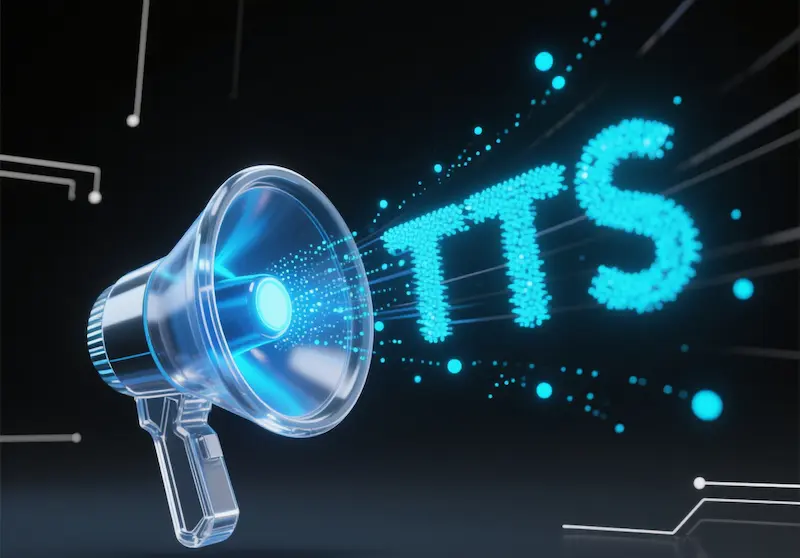What Is TTS? Exploring the Meaning of TTS & Beyond 🎙️
2025-06-12
Hey there! Ever asked yourself “what is TTS?” or wondered about the “TTS meaning” behind all this hype? Let’s unpack it, peek into top models like OpenAI and Google, and meet a rising star—Chatterbox TTS.

🔍 1. What Is TTS & What Does TTS Mean?
- TTS (Text‑to‑Speech) is tech that converts written text into spoken audio.
- Essentially, it turns text into speech, making content accessible, interactive, and expressive.
- From accessibility tools and audiobooks to chatbots and voice agents—TTS is everywhere.
⚙️ 2. How TTS Works
Here’s a clearer, more detailed look at the magic behind converting text into speech:
🔄 1. Text Preprocessing & Linguistic Analysis
- Text normalization: Converts “123” into “one‑two‑three”, expands abbreviations (“Dr.” → “Doctor”), handles punctuation, etc. :contentReference[oaicite:1]{index=1}
- Phonetic transcription: Maps written text into phonemes—the distinct sounds of speech—to ensure accurate pronunciation :contentReference[oaicite:2]{index=2}
- Linguistic features: Analyses parts of speech, sentence structure, and semantic context to guide how it should be said :contentReference[oaicite:3]{index=3}
🧠 2. Prosody Prediction (Pitch, Duration, Energy)
- Determines when to pause, which words to stress, and how intonation should rise or fall.
- Neural models like Tacotron 2 or FastSpeech estimate pitch contours and timing based on punctuation and context (“?” triggers rise, commas introduce pause) :contentReference[oaicite:4]{index=4}
🎵 3. Acoustic Feature Generation
- A neural acoustic model (e.g., encoder–decoder with attention) converts linguistic/prosodic input into a mel-spectrogram—a visual-like representation of sound patterns :contentReference[oaicite:5]{index=5}
- End‑to‑end systems (Tacotron, FastSpeech) learn this mapping directly, bypassing old multi‑stage systems :contentReference[oaicite:6]{index=6}
🔊 4. Neural Vocoder: From Features to Audio
- Vocoders like WaveNet, WaveGlow, Parallel WaveGAN turn those spectrograms into raw audio waveforms.
- WaveNet generates samples one by one with dilated convolutions—great quality but slow. Newer vocoders like WaveGlow generate faster while keeping quality :contentReference[oaicite:7]{index=7}
✅ 5. Training & Optimization
- Models are trained end-to-end on paired text-audio datasets (e.g., LJSpeech, LibriTTS) using losses that compare predicted audio features with real recordings :contentReference[oaicite:8]{index=8}
- Prosody and style tokens (e.g., “happy”, “questioning”) can be used to steer tone and expressiveness. SSML markup may also be supported :contentReference[oaicite:9]{index=9}
Putting it all together, the TTS pipeline looks like this:
- Text input → 2. Normalization + phonemes + linguistics → 3. Prosody prediction → 4. Spectrogram generation → 5. Audio waveform synthesis → Natural-sounding speech
Modern approaches merge many steps into one smooth, learned system—so TTS today sounds expressive, natural, and context-aware. It’s not magic, just brilliant engineering and tons of data 😌.
🚀 3. Leading TTS Models: OpenAI & Google
OpenAI TTS
- Offers TTS‑1 and TTS‑1‑HD, with six voices and real‑time/studio options :contentReference[oaicite:1]{index=1}.
- Recently launched gpt‑4o‑mini‑tts—you can steer tone (“sympathetic agent”, “bedtime story”) :contentReference[oaicite:2]{index=2}.
Google Cloud TTS
- Powered by WaveNet and their new Chirp HD voices (~380 voices in 50+ languages).
- Gemini 2.5 voices add controllability, emotion, and seamless language switching.
🌟 4. Why TTS Is Hot Right Now
- Accessibility: Helps visually impaired or multitaskers consume content.
- Automation: Empowers chatbots, IVR, real-time narration.
- Content creation: From audiobooks to educational videos.
- Entertainment & gaming: Characters with emotion, tone, personality.
Steadic semantic control and style steering mean TTS now acts.
🤖 5. Enter Chatterbox TTS: Open-Source Powerhouse
Introducing Chatterbox TTS by Resemble AI—a standout among TTS models :contentReference[oaicite:3]{index=3}:
- Open-source & MIT-licensed: production-grade and no pricing barrier.
- Emotion exaggeration control: first open-source model with dramatic or calm voice intensity.
- Zero-shot voice cloning: generate new voices with just seconds of reference audio.
- Ultra low latency (~200 ms): ideal for live chatbots & interactive applications.
- Watermarked audio: built-in ethical safeguard.
- Benchmarked preferred over ElevenLabs in side‑by‑side tests :contentReference[oaicite:4]{index=4}.
🎯 Ready to Hear It in Action?
Experiment with Chatterbox TTS now—give your site or project a voice upgrade: